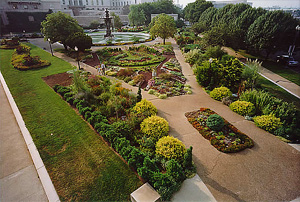|
| |
 The Park was created in 1932 and named for Frederic Auguste Bartholdi, the sculptor of the historic fountain located at its center. The beds in the Park were geometrically arranged and planted in formal classical style to feature the fountain and to accommodate public gatherings. The plantings have been redesigned during the last decade and are continuously updated to reflect modern trends in American horticulture and new plant introductions. The Park now serves as a home landscape demonstration garden and showcases innovative plant combinations in a variety of styles and design themes. The U.S. Botanic Garden Administration Building is located in the Park. The Park was created in 1932 and named for Frederic Auguste Bartholdi, the sculptor of the historic fountain located at its center. The beds in the Park were geometrically arranged and planted in formal classical style to feature the fountain and to accommodate public gatherings. The plantings have been redesigned during the last decade and are continuously updated to reflect modern trends in American horticulture and new plant introductions. The Park now serves as a home landscape demonstration garden and showcases innovative plant combinations in a variety of styles and design themes. The U.S. Botanic Garden Administration Building is located in the Park.
The Bartholdi Fountain  The fountain was designed symmetrically in three identical sections. The triangular base with turtles and large shells rises to the pedestal, from which three identical nereids (sea nymphs) rise on thirds. Between their feet are fish and scattered sea shells and coral. The nymphs, with arched backs, are caryatids, following a tradition of sculpture founded in classical Greece. They seem to hold up the large basin, which is actually supported by the central column. The nymphs wear headdresses of leaves. Their clinging drapery, clasped by shells at the waist, reveals their supple figures. Despite its monumental size (it weighs approximately 40 tons and is 30 feet high, and the sculptured female figures are 11 feet tall), each element of the fountain is beautifully detailed. The fountain was designed symmetrically in three identical sections. The triangular base with turtles and large shells rises to the pedestal, from which three identical nereids (sea nymphs) rise on thirds. Between their feet are fish and scattered sea shells and coral. The nymphs, with arched backs, are caryatids, following a tradition of sculpture founded in classical Greece. They seem to hold up the large basin, which is actually supported by the central column. The nymphs wear headdresses of leaves. Their clinging drapery, clasped by shells at the waist, reveals their supple figures. Despite its monumental size (it weighs approximately 40 tons and is 30 feet high, and the sculptured female figures are 11 feet tall), each element of the fountain is beautifully detailed.
The curved arms of the nereids lead the viewer's eye to the large basin above, which supports twelve lights. The fountain continues with three youthful tritons playfully holding out seaweed and is topped by a mural crown resembling a crenellated city wall. Water spills from the crown over the tritons and splashes into the upper basin, while jets shoot from the mouths of the fish and the turtles.
Frederic Auguste Bartholdi (1834-1904) created the fountain for the 1876 International Centennial Exhibition in Philadelphia. The design was based on a model he had created in 1867. Bartholdi was also working on his design for the Statue of Liberty at the same time. The fountain, cast in Paris by A. Durenne, was painted to look like bronze and placed at a focal point near the main entrance of the Exhibition grounds in Fairmount Park.
At the close of the Exhibition, the fountain was purchased for $6,000 (half of its estimated value) by the United States government at the suggestion of Frederick Law Olmsted, the famous landscape architect who designed the Capitol Grounds. It was moved to Washington, D.C., in 1877 and placed at the base of Capitol Hill near the center line of the Mall, on what was then the Botanic Garden grounds.
When it was created, the fountain fused modern gas-lighting and cast-iron technologies with water and was intended to allegorically represent Light and Water. Bartholdi saw this work as symbolically appropriate for the modern city, and he hoped that many cities throughout the country would purchase castings. Actually only Reims, France, acquired one in 1885, and it is no longer extant.
The gas lamps made the fountain a popular attraction since it was one of the first monuments in the city of Washington to be brightly illuminated at night. The lights surrounding the basin were added in 1886, and the round glass globes replaced the original gas fixtures when the fountain was fitted for electric lighting in 1915.
During the 1927 relocation of the Botanic Garden, the fountain was dismantled and stored. In 1932, it was re-erected in its present location. The park where the fountain stands was renamed in honor of Frederic Auguste Bartholdi in 1985.
The Bartholdi Fountain was restored in 1986. The rusted supporting bolts and rods and the plumbing and wiring were replaced. Dozens of layers of paint were sandblasted from the cast-iron surface, which was then given a new protective coating. The basins were repaired and leveled so that the water now falls evenly. The top coat of paint was renewed in 1996.
+ Learn More
|
|
|
United States Botanic Garden, 100 Maryland Ave., SW, Washington, DC 20001
Contact Us | 202-225-8333
|
|